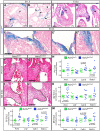Wnt/β-catenin signaling enables developmental transitions during valvulogenesis
- PMID: 26893350
- PMCID: PMC4813288
- DOI: 10.1242/dev.130575
Wnt/β-catenin signaling enables developmental transitions during valvulogenesis
Abstract
Heart valve development proceeds through coordinated steps by which endocardial cushions (ECs) form thin, elongated and stratified valves. Wnt signaling and its canonical effector β-catenin are proposed to contribute to endocardial-to-mesenchymal transformation (EMT) through postnatal steps of valvulogenesis. However, genetic redundancy and lethality have made it challenging to define specific roles of the canonical Wnt pathway at different stages of valve formation. We developed a transgenic mouse system that provides spatiotemporal inhibition of Wnt/β-catenin signaling by chemically inducible overexpression of Dkk1. Unexpectedly, this approach indicates canonical Wnt signaling is required for EMT in the proximal outflow tract (pOFT) but not atrioventricular canal (AVC) cushions. Furthermore, Wnt indirectly promotes pOFT EMT through its earlier activity in neighboring myocardial cells or their progenitors. Subsequently, Wnt/β-catenin signaling is activated in cushion mesenchymal cells where it supports FGF-driven expansion of ECs and then AVC valve extracellular matrix patterning. Mice lacking Axin2, a negative Wnt regulator, have larger valves, suggesting that accumulating Axin2 in maturing valves represents negative feedback that restrains tissue overgrowth rather than simply reporting Wnt activity. Disruption of these Wnt/β-catenin signaling roles that enable developmental transitions during valvulogenesis could account for common congenital valve defects.
Keywords: Atrioventricular canal; Axin2; Chordae tendineae; Cushion mesenchyme; EMT; Heart valves; Lef1; Mitral valve; Outflow tract; Spongiosa; Tenascin; Versican; Wnt/β-catenin signaling.
© 2016. Published by The Company of Biologists Ltd.
Conflict of interest statement
The authors declare no competing or financial interests.
Figures







References
-
- Al Alam D., Green M., Tabatabai Irani R., Parsa S., Danopoulos S., Sala F. G., Branch J., El Agha E., Tiozzo C., Voswinckel R. et al. (2011). Contrasting expression of canonical Wnt signaling reporters TOPGAL, BATGAL and Axin2LacZ during murine lung development and repair. PLoS ONE 6, e23139 10.1371/journal.pone.0023139 - DOI - PMC - PubMed
Publication types
MeSH terms
Substances
Grants and funding
LinkOut - more resources
Full Text Sources
Other Literature Sources
Molecular Biology Databases

